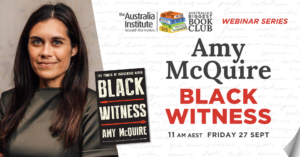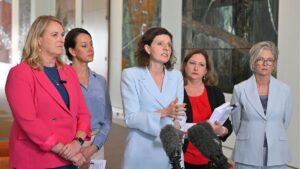by Richard Denniss
[Originally published by Guardian Australia, 14 October 2020]
What should Australia spend half a trillion dollars on over the next 10 years? After decades of being told we “can’t afford” to spend more to help the unemployed, the disabled or to reduce carbon emissions, the Morrison government is set to embark on the largest-ever spending program in our history. But what should they spend it on?
The idea that cutting taxes or building roads will create jobs is as banal as it is misleading. With about a million unemployed workers in Australia today, any tax cuts or new spending will create some jobs, but that’s like saying squirting a garden hose at a bushfire will make some difference. If the government was serious about creating the maximum number of jobs or maximising the long-run benefits of its spending, it would have mapped out a wide range of options and inquired into the relative benefits of each. But it hasn’t. The treasurer, Josh Frydenberg, just told us that building things and giving tax cuts is “good for the economy”.
There is no doubt that employing aged care workers, childcare workers or more staff to answer the phone at Centrelink will create more jobs, per million dollars spent, than granting income tax cuts. None. In addition to instantly creating a significant number of “direct jobs”, when the aged care workers and public servants spend their incomes their wages will “trickle across” to create jobs in cafes and shops. The idea that only rich people spending windfalls can deliver “trickle down” benefits has nothing to do with economics.
The same is true for pouring concrete. Of course, building a tunnel will create some jobs, but the government hasn’t provided any empirical evidence to support the claim that — of all the ways to spend billions of dollars — building roads or tunnels will create more short-term jobs or long-term benefits than employing more people to teach in our universities, protect our elderly from Covid-19 or help our national parks recover from last year’s bushfires. None.
Parliament frequently inquires into proposed policy changes. The Senate is currently inquiring into patient access to medicinal cannabis and the House of Representatives is inquiring into timber supply chain constraints. In addition to those biggies, the 12 commissioners and 168 staff of the Productivity Commission, having recently finished a report into the tax concessions we pay to workers in remote areas, has no current inquiry into better or worse ways to spend $500bn creating jobs and lasting benefits for Australia.
If the Morrison government decides to spend $1bn on childcare workers or aged care workers, it will create significantly more jobs than if it spent the same amount building a bridge. This assertion is not based on ideology or personal preference, it is simply based on the Australian Bureau of Statistics data on the “labour intensity” of different industries. We literally have official data on the jobs created per million spent in each industry and the Morrison government is literally ignoring that data when it claims it is doing “everything it can” to create jobs.
But it’s not just the number of jobs that is impacted by the choice of where to spend $1bn, or $500bn, it’s the type of jobs as well. Some industries employ more women, for example, and some industries employ people all across the country, rather than in concentrated geographical areas.
Australia is currently observing the biggest bait-and-switch in our history. The people who spent decades arguing we have to spend public money very carefully are currently spending more money than any government, faster than any government, and with less scrutiny than any government. Back in February it made sense to argue that the pace of spending was more important than the precision. But eight months into the crisis it is time we started to see some evidence to back up the Morrison government’s claims to good economic management.
The prime minister, Scott Morrison, and the treasurer have spent all year describing their approach to spending half a trillion dollars as “temporary and targeted”, but last week’s budget makes clear the deficits will be with us for a decade and that policies like jobkeeper are being sprayed around so widely that it’s going to companies paying huge bonuses to their CEOs.
There is no technical analysis to inform the most expensive policy choices in our history, no clear criteria for comparing the options we face and no parliamentary or bureaucratic inquiries designed to widen and improve the menu of spending options before us.
No one disputes the fact that Australia will soon have a public debt of around $1tn, and no one who understands economics is terribly worried about that fact in isolation. For decades Australia has been one of the richest countries in the world and has had a far lower level of public debt than most developed countries. That will still be true after this crisis.
But that does not mean Australians should not be both concerned about, and involved in, decisions about how half a trillion dollars will be spent. Just as the Snowy River Scheme, which started to produce electricity in 1955, continues to deliver benefits today, the Ord River Scheme began construction in 1940s and continues to cost us money. And just as Gough Whitlam’s decision to make university free in the 1970s still delivers benefits today (to baby boomers at least), Tony Abbott’s decision to build a broadband network on old copper wires still haunts us today. Decision making matters.
The idea that public spending is good and that public debt isn’t inherently bad has – unexpectedly – been rapidly and widely accepted. But the newfound faith in the benefits of stimulus spending should not erase long standing scepticism about the claimed benefits of that spending. Different people will inevitably have different priorities and different time horizons, but we should all be united in the hunt for boondoggles and white elephants.
Building white elephants and gold-plated boondoggles will create some jobs, but investing in high quality services will create far more jobs and deliver lasting benefits to the community. If the government believes it is spending money wisely, then it should provide all of the analysis on which its decisions have been made. Australia can afford to do anything we want but even in a crisis we can’t afford to do everything we want. It’s not public debt that will burden future generations, it’s white elephants.
Richard Denniss is the chief economist at independent thinktank The Australia Institute
Between the Lines Newsletter
The biggest stories and the best analysis from the team at the Australia Institute, delivered to your inbox every fortnight.
You might also like
Extract: Black Witness by Amy McQuire
This is an extract from Black Witness by Amy McQuire, published by University of Queensland Press.
An Australian whistleblower rewards scheme could reduce white-collar crime while raising billions in revenue
It is not often we can look to America for good public policy – but they have one good idea about helping encourage corporate whistleblowers while also raising revenue.
Who votes with whom? Beware claims that use voting records to argue politicians have similar views
Sky News says community independent MP Allegra Spender supports more Coalition motions than Greens motions. But They Vote for You says Spender votes with Greens MPs more often than Coalition MPs. That both those claims are made about the same person is proof that voting comparisons are fraught. It is just as confusing when it


